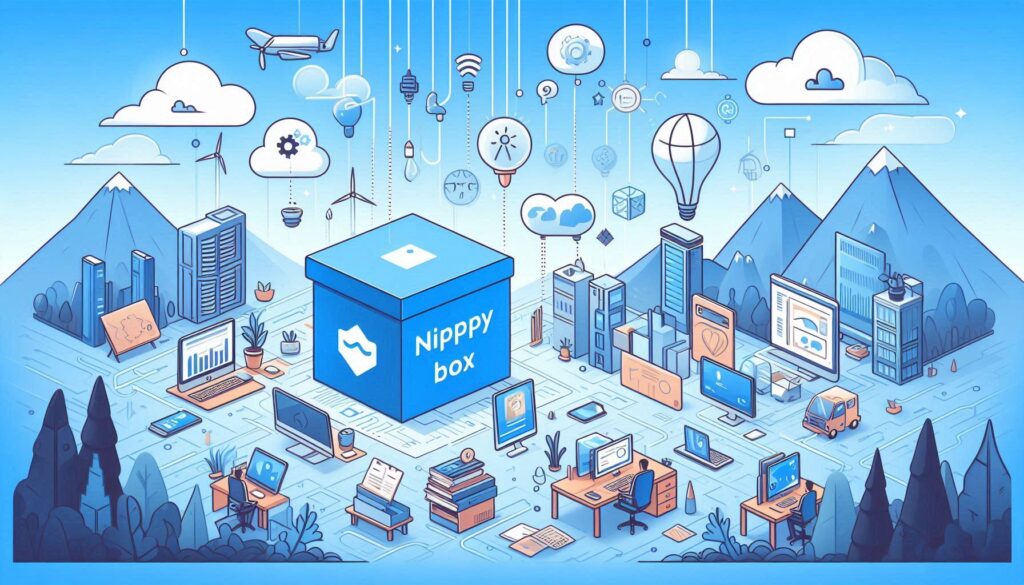NippyBox was a cloud-based file-sharing and storage platform that emerged as a lightweight, user-friendly alternative to giants like Google Drive and Dropbox. Launched to cater to individuals, freelancers, and small businesses, it offered a simple interface, robust security, and affordable pricing.
Despite its initial success, NippyBox was discontinued in 2025, leaving users to seek alternatives.
This article explores how NippyBox worked, why it shut down, and its place in the cloud storage landscape, providing a comprehensive and unique perspective for tech enthusiasts and bloggers.
How to Use NippyBox (Historical Usage Guide)
Since NippyBox is no longer operational, the following guide is based on historical documentation of its functionality when it was active. It outlines the steps users followed to leverage the platform’s features.
Step-by-Step Usage
-
Account Creation : Users visited the NippyBox website and registered by entering an email address and password. The sign-up process was designed to be quick, requiring minimal personal information to get started.
-
File Uploads : After logging in, users could upload files by selecting the “Upload” button or dragging and dropping files into the browser. The platform supported multiple file types, including documents, images, audio, and videos, with a 100 MB per-file limit on the free plan.
-
File Storage and Organization : Uploaded files were stored in the user’s personal cloud space. Users could create folders to organize their files, making it easier to manage documents or media. The platform ensured files were accessible from any internet-connected device, such as desktops, tablets, or smartphones.
-
File Sharing : NippyBox allowed users to generate shareable links for their files. These links could be sent to others for downloading or viewing. Additional features included setting expiration dates or download limits for enhanced control over shared content.
-
Cross-Device Synchronization : Files were automatically synced across all devices linked to the user’s account. This ensured that the latest versions of files were always available, regardless of whether the user was accessing them from a phone, tablet, or computer.
-
File Deletion : Users could delete files directly from the NippyBox dashboard. However, deleted files were not recoverable, so caution was advised when removing content.
-
Security Measures : NippyBox employed encryption to protect files during upload and while stored on its servers. This focus on security made it appealing for users handling sensitive data.
-
Access Requirements : An internet connection was necessary to use NippyBox, as it was entirely cloud-based. This allowed for flexibility but meant offline access was not available.
Key Features
-
Intuitive Interface: NippyBox was praised for its clean, easy-to-navigate design, suitable for users with varying technical expertise.
-
Security: End-to-end encryption and secure transfer protocols ensured data privacy.
-
Affordable Plans: A free tier offered 5 GB of storage, with paid plans starting at $3/month for additional capacity and features.
-
Cross-Platform Access: Compatibility with Windows, macOS, iOS, and Android made it versatile for users across devices.
-
Collaboration Tools: Basic sharing features allowed teams to collaborate, though advanced real-time editing was absent.
Limitations
-
Storage Constraints: The free plan’s 5 GB storage and 100 MB file size limit were restrictive compared to competitors like Google Drive’s 15 GB free tier.
-
Limited Collaboration: Unlike Dropbox or Google Drive, NippyBox lacked advanced tools for real-time document editing or third-party integrations.
-
Support Challenges: Some users reported slow customer support response times, which could hinder issue resolution.
Reasons for Discontinuation
NippyBox ceased operations in 2025, and several factors contributed to its shutdown. Based on official statements and industry analysis, the following reasons explain why the service could not continue:
-
Financial Challenges : Running a cloud storage service requires substantial investment in servers, bandwidth, and security infrastructure. NippyBox struggled to cover these costs, particularly as it relied heavily on a free tier without a sustainable revenue model. Unlike competitors with premium subscriptions or corporate partnerships, NippyBox lacked consistent income to support its operations.
-
Legal and Compliance Issues : The platform faced challenges related to copyright infringement, as some users uploaded pirated content like movies or software. This led to Digital Millennium Copyright Act (DMCA) takedown requests and potential legal scrutiny, increasing operational risks and costs.
-
Security and Misuse Risks : NippyBox was vulnerable to misuse, such as the upload of malware or illegal files. Without robust oversight, this exposed the platform to data breaches and legal penalties, further straining its resources.
-
Intense Market Competition : The cloud storage market is dominated by established players like Google Drive, Dropbox, and Mega. These platforms offered larger storage, advanced collaboration tools, and better integration with productivity suites. NippyBox’s simpler feature set and freemium model couldn’t compete with the scalability and reliability of these giants.
Impact of Shutdown
When NippyBox shut down, its website became inaccessible, and users lost access to their stored files and login credentials. This underscored the risks of relying on smaller cloud storage providers. Users were encouraged to transition to more established services to avoid similar disruptions.
Comparison with Competitors
NippyBox was often compared to other cloud storage platforms. The table below highlights key differences based on historical data:
|
Feature |
NippyBox |
Google Drive |
Dropbox |
Mega |
|---|---|---|---|---|
|
Free Storage |
5 GB |
15 GB |
2 GB |
20 GB |
|
File Size Limit (Free) |
100 MB |
5 GB |
No limit |
10 GB |
|
Encryption |
End-to-end encryption |
In-transit and at-rest encryption |
In-transit and at-rest encryption |
End-to-end encryption |
|
Collaboration Tools |
Basic sharing (no real-time editing) |
Real-time editing (Google Workspace) |
Real-time editing and collaboration |
Basic sharing |
|
Cross-Platform Access |
Yes (Windows, macOS, iOS, Android) |
Yes (all major platforms) |
Yes (all major platforms) |
Yes (all major platforms) |
|
Pricing (Starting) |
$3/month |
$1.99/month (100 GB) |
$9.99/month (2 TB) |
$4.99/month (400 GB) |
NippyBox’s affordability and simplicity were its strengths, but its limited storage and lack of advanced features made it less competitive.
User Experiences and Legacy
Before its discontinuation, NippyBox received mixed feedback. Users appreciated its ease of use and privacy focus, particularly for quick file transfers. However, some criticized its limited storage and lack of advanced collaboration tools. The shutdown was a disappointment for its niche user base, highlighting the challenges smaller platforms face in a competitive market.
The history of NippyBox offers lessons for tech bloggers and startups. It demonstrates the importance of a sustainable business model, robust legal compliance, and the ability to scale features to meet user demands. For users, it serves as a reminder to back up data and choose reliable, established services for long-term storage needs.
Alternatives to NippyBox
With NippyBox no longer available, users can explore the following alternatives:
-
Google Drive: Offers 15 GB of free storage and seamless integration with Google Workspace for collaboration.
-
Dropbox: Known for robust collaboration tools and reliable file syncing, ideal for teams.
-
Mega: Provides 20 GB of free storage with a strong focus on end-to-end encryption for privacy-conscious users.
-
OneDrive: Integrates with Microsoft 365, offering 5 GB free storage and advanced productivity features.
Conclusion
NippyBox was a promising cloud storage and file-sharing service that prioritized simplicity, security, and affordability. However, financial constraints, legal challenges, security risks, and competition from larger platforms led to its discontinuation in 2025. While it served a niche audience well, its shutdown underscores the challenges of sustaining a cloud storage service in a crowded market. Tech bloggers and users can learn from NippyBox’s story, emphasizing the need for scalability and reliability when choosing or building cloud solutions.



